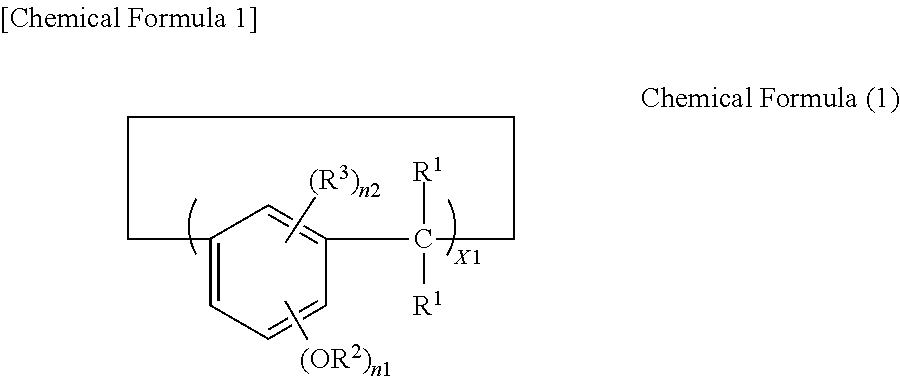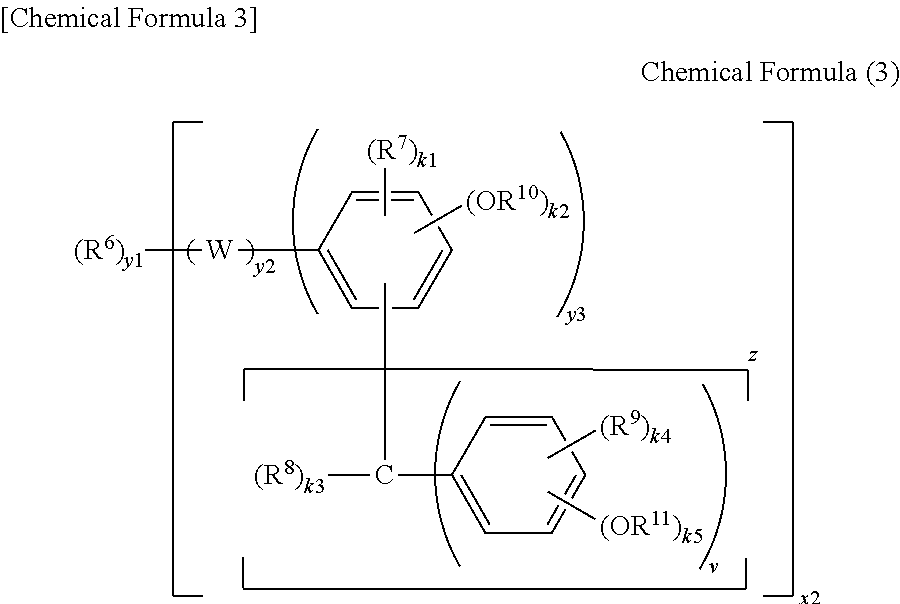Negative resist composition, method for producing relief pattern using the same, and electronic component using the same
a composition and negative resist technology, applied in the field of negative resist composition, can solve the problems of inability to develop alkali developing solutions, inability to form uniform resist films, and limit to decreasing resolution or ler, so as to increase the content of phenolic compounds, reduce the roughness of line edges, and reduce the effect of ler
- Summary
- Abstract
- Description
- Claims
- Application Information
AI Technical Summary
Benefits of technology
Problems solved by technology
Method used
Image
Examples
synthesis example 1
[0220]5.8 g (10 mmol) of a phenolic compound represented by the following chemical formula (10) (parent compound: Pre-1) (TEP-BOCP: Asahi Organic Chemicals Industry Co., Ltd.) was added to a solution of 20 mL of 10% by weight potassium hydroxide aqueous solution and 20 mL of ethanol. The mixture was stirred at room temperature to dissolve. To this solution, 14.0 mL (160 mmol) of a 37% formalin aqueous solution was added slowly at room temperature. Under nitrogen atmosphere, the solution was stirred at 40° C. for 24 hours and then poured into 200 mL water in a beaker. With cooling the beaker in an ice bath, a 2.0 wt % acetic acid aqueous solution was slowly added so that the mixed solution has a pH of 5.0. The resulting precipitate was collected by filtration, washed thoroughly with water and then dried, thereby obtaining a phenolic compound mixture (A-01M) having 4 to 8 hydroxymethyl groups incorporated thereinto. The phenolic compound mixture was purified by high-performance liquid...
synthesis example 2
[0222]A phenolic compound 2 (A-02) represented by the following chemical formula (13) was synthesized in the same manner as Synthesis Example 1, except that 4.5 g (10 mmol) of a phenolic compound (Pre-2) represented by the following chemical formula (12) (TEOC-DF: Asahi Organic Chemicals Industry Co., Ltd.) was used in place of the phenolic compound (Pre-1). As a result, 4.3 g of a white compound was obtained.
[0223]The structure of the thus-obtained phenolic compound 2 (A-02) was confirmed with 1H-NMR spectrum and MALDI-TOF MS. The glass transition temperature was obtained by differential scanning calorimetry. The analysis results are shown in Table 1.
synthesis example 3
[0224]Under nitrogen atmosphere, 16.6 g (0.1 mol) of 1,3-diethoxybenzene was dissolved in 400 mL of ethanol in a 300 mL three-necked flask. With cooling the flask in an ice bath, 12.2 g (0.1 mol) of 4-hydroxybenzaldehyde was added thereto. Then, 20 mL of concentrated hydrochloric acid was added thereto slowly and dropwise and reacted at 75° C. for 12 hours. After reaction completion, the resulting reaction solution was cooled in an ice bath. The thus-precipitated crystal was collected by filtration, washed with distilled water until it is neutralized, and then dried. The resultant was purified by recrystallization using N,N-dimethylformamide as a solvent, thereby obtaining 9.6 g of a light yellow phenolic compound (Pre-3) represented by the following chemical formula (14).
[0225]A phenolic compound 3 (A-03) represented by the following chemical formula (15) was synthesized in the same manner as Synthesis Example 1, except that 1.1 g (1 mmol) of a phenolic compound (Pre-3) represented...
PUM
| Property | Measurement | Unit |
|---|---|---|
| Percent by mass | aaaaa | aaaaa |
| Wavelength | aaaaa | aaaaa |
| Glass transition temperature | aaaaa | aaaaa |
Abstract
Description
Claims
Application Information
 Login to View More
Login to View More - R&D
- Intellectual Property
- Life Sciences
- Materials
- Tech Scout
- Unparalleled Data Quality
- Higher Quality Content
- 60% Fewer Hallucinations
Browse by: Latest US Patents, China's latest patents, Technical Efficacy Thesaurus, Application Domain, Technology Topic, Popular Technical Reports.
© 2025 PatSnap. All rights reserved.Legal|Privacy policy|Modern Slavery Act Transparency Statement|Sitemap|About US| Contact US: help@patsnap.com



